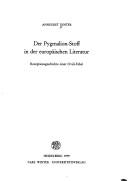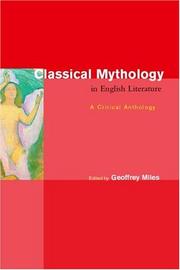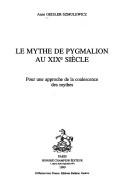| Listing 1 - 8 of 8 |
Sort by
|

ISBN: 3533027759 3533027767 9783533027751 9783533027768 Year: 1979 Volume: 11 Publisher: Heidelberg Winter
Abstract | Keywords | Export | Availability | Bookmark
 Loading...
Loading...Choose an application
- Reference Manager
- EndNote
- RefWorks (Direct export to RefWorks)
Comparative literature --- Thematology --- Ovid --- Pygmalion (Greek mythology) --- Pygmalion (Mythologie grecque) --- Ovid, --- Pygmalion (Greek mythology) in literature --- European literature --- History and criticism --- 87.04 --- 871 OVIDIUS NASO, PUBLIUS --- Klassieke literatuur: thema's --- Latijnse literatuur--OVIDIUS NASO, PUBLIUS --- Pygmalion (Greek mythology) in literature. --- History and criticism. --- 871 OVIDIUS NASO, PUBLIUS Latijnse literatuur--OVIDIUS NASO, PUBLIUS --- 87.04 Klassieke literatuur: thema's --- Pygmalion --- European literature - History and criticism --- Pygmalion (greek mythology) --- Pygmalion dans la litterature
Book
ISBN: 3631333110 9783631333112 Year: 1998 Volume: 1673 Publisher: Frankfurt am Main Lang
Abstract | Keywords | Export | Availability | Bookmark
 Loading...
Loading...Choose an application
- Reference Manager
- EndNote
- RefWorks (Direct export to RefWorks)
Book
ISBN: 9782810704149 2810704147 Year: 2016 Publisher: Toulouse Presses universitaires du midi
Abstract | Keywords | Export | Availability | Bookmark
 Loading...
Loading...Choose an application
- Reference Manager
- EndNote
- RefWorks (Direct export to RefWorks)
Lorsqu'on évoque le mythe de Pygmalion, on pense à l'histoire de ce sculpteur qui, grâce à l'intervention de la déesse de l'Amour, voit sa statue d'ivoire prendre vie. Or, si on reprend dans tous les détails le récit d'Ovide, on s'aperçoit que c'est le sculpteur par son art qui anime sa créature, Vénus ne faisant que parfaire la métamorphose. C'est ce processus de création d'une femme idéale par un artiste opérant sur la base d'une projection de son désir sur le corps féminin qui est étudié ici. Pour cela, ont été mis en perspective plusieurs domaines de création (littérature, cinéma) avec le mythe fondateur afin d'analyser les diverses modalités de la "fabrication" d'une femme et de son image par un homme de l'art ainsi que la relation qui les unit. Cette recherche s'inscrit dans le champ très large d'une anthropologie du corps et de l'image à la croisée de plusieurs disciplines (histoire de l'art, lettres, ethnologie, sociologie). L'analyse du processus créatif à l'oeuvre dans chacun des domaines étudiés au-delà de la singularité de chaque création, révèle une continuité dans la configuration de l'acte créateur que même la rupture introduite par la reproductibilité technique des images ne vient pas remettre en question. Regards d'hommes sur des corps de femmes, regards créateurs de créatures, cet ouvrage met en lumière une facette des rapports entre le féminin et le masculin explorée à travers la problématique de l'image.
Sociology of culture --- Art --- theme --- Pygmalion --- Pygmalion (Greek mythology) --- Art and mythology --- Arts, Modern --- Creation (Literary, artistic, etc.) --- Themes, motives --- women [female humans] --- human figures [visual works] --- Pygmalion [Mythological character] --- Arts, Modern - Themes, motives --- ideale schoonheid
Book
ISBN: 9075697597 9789075697599 Year: 2001 Publisher: Nijmegen Vantilt
Abstract | Keywords | Export | Availability | Bookmark
 Loading...
Loading...Choose an application
- Reference Manager
- EndNote
- RefWorks (Direct export to RefWorks)
Dutch literature --- Pygmalion (Greek mythology) in literature --- History and criticism --- 839.3 <09> --- Nederlandse literatuur--Geschiedenis van ... --- 839.3 <09> Nederlandse literatuur--Geschiedenis van ... --- Nederlandse literatuur--Geschiedenis van .. --- Dutch literature - History and criticism --- Nederlandse literatuur--Geschiedenis van
Book
ISBN: 9780226775210 0226775216 Year: 2008 Publisher: Chicago University of Chicago press
Abstract | Keywords | Export | Availability | Bookmark
 Loading...
Loading...Choose an application
- Reference Manager
- EndNote
- RefWorks (Direct export to RefWorks)
Between life and the art that imitates it is a vague, more shadowy category: images that exist autonomously. Pygmalion's mythical sculpture, which magnanimous gods endowed with life after he fell in love with it, marks perhaps the first such instance in Western art history of an image that exists on its own terms, rather than simply imitating something (or someone) else. In 'The Pygmalion Effect', Victor I. Stoichita delivers this living image& as well as its many avatars over the centuries& from the long shadow cast by art that merely replicates reality. Stoichita traces the reverberations of Ovid's founding myth from ancient times through the advent of cinema. Emphasizing its erotic origins, he locates echoes of this famous fable in everything from legendary incarnations of Helen of Troy to surrealist painting to photographs of both sculpture and people artfully posed to simulate statues. But it was only with the invention of moving pictures, Stoichita argues, that the modern age found a fitting embodiment of the Pygmalion story's influence. Concluding with an analysis of Alfred Hitchcock films that focuses on Kim Novak's double persona in 'Vertigo', 'The Pygmalion Effect' illuminates the fluctuating connections that link aesthetics, magic, and technical skill. In the process, it sheds new light on a mysterious world of living artifacts that, until now, has occupied a dark and little-understood realm in the history of Western image making.
Comparative religion --- Art --- Metamorphosis in art --- Metamorphosis in literature --- Mimesis in art --- Mimesis in literature --- Pygmalion (Greek mythology) --- Metamorphosis in art. --- Metamorphosis in literature. --- Mimesis in art. --- Mimesis in literature. --- kunst --- iconografie --- iconologie --- Pygmalion --- mythologie --- Ovidius --- mimesis --- film --- schilderkunst --- fotografie --- Hitchcock Alfred --- Vertigo --- metamorfose --- modellen --- beeldhouwkunst --- oudheid --- 7.046 --- Pygmalion (Greek mythology). --- Mythology, Greek --- Representation (Literature) --- Imitation in literature --- Realism in literature --- Imitation in art

ISBN: 0415147557 0415147549 9780415147545 9780415147552 Year: 1999 Publisher: London ; New York, NY : Routledge,
Abstract | Keywords | Export | Availability | Bookmark
 Loading...
Loading...Choose an application
- Reference Manager
- EndNote
- RefWorks (Direct export to RefWorks)
British literature --- Britse literatuur --- Engelse literatuur --- English literature --- Littérature anglaise --- Littérature britannique --- Mythologie [Klassieke ] in de literatuur --- Mythologie classique dans la littérature --- Mythology [Classical ] in literature --- Mythology, Classical --- Pygmalion (Greek mythology) --- Mythology, classical, in literature --- Orpheus --- Adonis --- 820 --- 291.13 --- Mythe. Vergelijkende mythologie --- 820 Engelse literatuur --- 291.13 Mythe. Vergelijkende mythologie --- Adonis (Greek deity) --- Mythology, Classical, in literature --- Orpheus (Greek mythology) --- Classical mythology --- Mythology, Greek --- Civilization, Classical --- Inklings (Group of writers) --- Nonsense Club (Group of writers) --- Order of the Fancy (Group of writers) --- Classical influences --- Mythology [Classical ] --- Literary collections --- 820 English literature. Literature in English --- English literature. Literature in English --- Mythology, Classical - Literary collections --- Pygmalion (Greek mythology) - Literary collections --- Orpheus - (Greek mythological character) - Literary collections --- Adonis - (Greek deity) - Literary collections --- ENGLISH LITERATURE --- CLASSICAL MYTHOLOGY IN LITERATURE --- PYGMALION (GREEK MYTHOLOGY) --- ADONIS (GREEK DEITY) --- CLASSICAL INFLUENCES --- Orpheus - (Greek mythological character) --- Adonis - (Greek deity)

ISBN: 274530013X 9782745300133 Year: 1999 Volume: 24
Abstract | Keywords | Export | Availability | Bookmark
 Loading...
Loading...Choose an application
- Reference Manager
- EndNote
- RefWorks (Direct export to RefWorks)
Creation dans la litterature --- Creation in literature --- Romanticism --- Romantiek --- Romantisme --- Schepping in de literatuur --- Literature, Modern --- Pygmalion (Greek mythology) --- Mythology in literature --- Littérature --- Pygmalion (Mythologie grecque) --- Mythologie dans la littérature --- Themes, motives --- Thèmes, motifs --- Littérature --- Mythologie dans la littérature --- Thèmes, motifs --- Literary collections --- Literature [Comparative ] --- 18th century --- 19th century --- Pygmalion --- Themes, motives.
Book
ISBN: 9782600005371 2600005374 Year: 2008 Volume: 37 Publisher: Genève : Droz,
Abstract | Keywords | Export | Availability | Bookmark
 Loading...
Loading...Choose an application
- Reference Manager
- EndNote
- RefWorks (Direct export to RefWorks)
Metamorphosis in art. --- Pygmalion (Greek mythology) --- Metamorphosis in literature. --- Mimesis in art. --- Mimesis in literature. --- Métamorphose dans l'art --- Pygmalion (Mythologie grecque) --- Métamorphose dans la littérature --- Mimêsis --- Mimésis dans la littérature --- Metamorphosis in art --- Metamorphosis in literature --- Mimesis in art --- Mimesis in literature --- Art --- Imitation dans l'art. --- Effet Pygmalion. --- Création (Arts) --- Philosophie. --- Métamorphose dans l'art --- Métamorphose dans la littérature --- Mimêsis --- Mimésis dans la littérature --- Pygmalion --- Création (Arts)
| Listing 1 - 8 of 8 |
Sort by
|

 Search
Search Feedback
Feedback About UniCat
About UniCat  Help
Help News
News